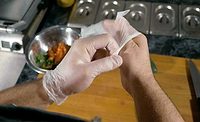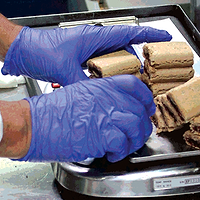A Food Safety Management Framework for Foodservice and Catering
Safe food is essential for life, and food safety has become a buzzword in most catering organizations. Despite the widely accepted gains emerging from adopting food safety management systems (FSMS) worldwide, the foodservice and catering sectors seem not to have made advances towards deploying such systems in improving their food safety and hygiene practices. The problem lies in the nature and complicated requirements and norms of the current frameworks and associated roadmaps towards effective implementation of food safety management initiatives. This paper proposes a food safety management framework for the foodservice and catering sector based on integrating several internationally recognized food safety and quality management systems, the international standard organization (ISO) 22000:2005 requirements for any organization in the food chain, Hazard Analysis and Critical Control Points (HACCP), the Codex Alimentarius Commission, and the quality management system ISO 9000:2008 series. It is expected that the proposed framework overcomes limitations inherent in other food safety management concepts and approaches, and is distinguished by its agility among constituents and can be used to self-assess an organization’s food safety management initiatives and efforts to assess their progress over time. The proposed framework is appropriate, feasible for implementation and was tested in an educational organization; it provides information and guidance to help caterers provide healthier and safer food for their customers.
Delivering safe food products with a level of quality that meets customer requirements is essential to business success. Indeed, in the fierce competition of today’s markets, the level of quality must exceed what customers already expect, and in a safe condition. Achieving this quality will involve the entire organization, and often suppliers and customers as well. It requires good management systems and practices throughout the organization and means having well-trained and motivated employees, standardized work procedures and effective controls. Global consumers are very concerned about safety of their food. The solution they call for is for food of high quality and integrity, safety guarantees and transparency. Governments are imposing new legislations; retailers are making new demands on their supply chains, which are reacting by implementing systems to improve product quality in an attempt to not only guarantee the safety of the products but also to raise the common community’s awareness of their efforts. Such efforts are performed at the level of either an individual organization or a complete supply chain network. Food safety, therefore, is considered an important issue for all stakeholders in the domain of food production as well as governments in setting new legislation regarding food safety.
Quality control has become a cornerstone of food safety policy over the past decade in the food industry development.[1] More focus has been placed on integrated quality management systems. These integrated systems include all steps in the food production chain, such as supply of raw materials, food manufacturing, packaging, transportation and logistics, research and development, maintenance of production equipments and training and education of staff. Moreover, food quality is associated with a proactive policy and the creation of controls to maintain a safe food supply. The business community in the food supply chain regards the call for safety from their customers, consumers, government and other stakeholders as an important driving force for continuous innovation. These innovations have focused on implementing systems to improve product quality and guarantee its safety as well as raise awareness of these innovations throughout their supply chain stakeholders. One of the important tools used to ensure food safety against hazard contamination is the HACCP system, which is a systematic approach to identify, evaluate and control steps in food manufacturing that are critical to product (food) safety. The introduction of HACCP in the food industry has resulted in the taking of greater responsibility for control of food safety risks and taking corrective actions.[1] HACCP is a means of assuring proper food handling, processing and retail sale to consumers. Although quality control in general and HACCP in particular have been implemented in manufacturing industries for decades, they are clearly ineffective and almost incapable of detecting food safety defects that occur at a low incidence, as there has been a lack of defining the CCP that has the function of eliminating or controlling identified hazards.[2] In addition, HACCP statements are confusing to the average caterer, and it was noted that complex microbiology and the intermittent use of its terms restricted assessability of documents.
Food Quality Standards
ISO standards are international standards that focus on management in order to achieve uniformity and prevent technical barriers to trade throughout the world. The ISO 9000 series of standards is a management quality standard; its aim is to evaluate a firm’s ability to effectively design, produce and deliver quality products and services. The standard only provides a framework with which to develop continuous product/service quality, and prevent nonconformity based on the organization’s requirements. This version of the standard tries to enhance customer satisfaction by including top management involvement, continual improvement and a systems approach, which is one of its eight quality principles.[3] The essence of an ISO 9000-based quality system is that all activities and handling must be established in procedures and must be followed by ensuring clear assignment of responsibilities and authorities. In September 2005, the ISO 22000 series: Global standards for safe food supply chains, which specifically aimed to manage safety in the food chain was published.[4] ISO 22000 is a standard that specifies the requirements for FSMS for all types of organizations within the food chain. The standard is in close cooperation with the Codes Alimentarius Commission based on national legislation and HACCP guidelines. The body was jointly established by the United Nation’s Food and Agriculture organization (FAO) and the World Health Organization (WHO) to develop food standards. A major benefit of integrating standards is that the ISO 22000:2005 standard for food safety can be applied in combination with quality management system ISO 9000:2008, the focus of which is quality management. Moreover, the ISO 22000:2005 standard will make it easier for organizations to implement HACCP in a harmonized manner, which does not vary by country. ISO technical specification ISO/TS 220002-1:2009 sets out requirements for prerequisite programs that are needed to realize safe products and provide food that is safe for human consumption. It is intended to be used in conjunction with and support the ISO 22000:2005 standard.
ISO 15161:2001
The ISO 15161:2001 guidelines for the application of the ISO 9000 series for the food and drink industry is a document that illustrates the interaction of the quality management system ISO 9000 with HACCP, and directs the implementation of ISO 9000 in the food industry. According to this standard, food safety is considered a part of quality.[5] However, certification by ISO 15161:2001 was not possible, and businesses in the food industry were certified according to ISO 9000 instead. The standard was later revised by ISO 22000 with the aim to ensure quality of all aspects of food production; its goal is continuous improvement of food safety processes. The standard is a more procedurally oriented than principly based and the ISO 22001 guidelines were developed for the application of ISO 9001 instead of ISO 15161:2001.
ISO 22000:2005
The ISO22000:2005 standard is a generic FSMS that dynamically combines the HACCP principles and application steps with prerequisite programs to determine the strategy to be used to ensure hazard control by obtaining the CCPs and eliminating them. Currently, HACCP principles are the basis of most food quality and safety assurance systems. The standard is applicable to all organizations, regardless of size, which are involved in any aspect of food chain and want to implement systems that consistently provide safe products. The ISO 22000:2005 standard is to be used for registration purposes, so that once a company has met the established requirements, it can apply to a certification body to be audited and issued an official certification that states that all FSMS requirements have been examined and met.
Other Food Safety Guidance Notes
The intense competitive pressures provide the motivation for continued efforts to deliver safer food and better business. The continuing demand for safe food has resulted in a proliferation of requirements for doing so. In fact, the market is flooded with methodologies for food safety and quality. As an example of the wide range of private standards that exist, the following quality guidance standards are presented.[6-8]
British retail consortium (BRC). This standard for food safety, originally developed by a trade body in the UK, is a private standard that is highly dynamic. It is much more specific about how to achieve certain goals and how to operationalize process standards than is the case with public standards. Recently, it was applied to suppliers in multiple countries.[9] In 1998, organizations took the initiative to define common criteria for the inspection of food product’s suppliers. Inspections are carried out by certified inspection organizations. BRC norms are consistent with HACCP norms, although more attention is paid to a documented quality management system, factory environment and facilities, product and process controls and personnel. BRC is considered a wide umbrella that cover mostly all the requirements identified by ISO 9001, ISO 22000 and HACCP.
EurepGAP. EurepGAP is an organization of more than 25 large European retailers and purchase organizations.[10] GAP stands for Good Agricultural Practices, which provides a holistic approach and a package of norms aiming to guarantee environmentally friendly, safe and high-quality products. EurepGAP pays more attention to food safety, human resources management and environmental measurements. The EurepGAP norms are more rigid than the EU governmental demands; its disadvantages are that it takes the legislation of the country where it is implemented as a starting point and that there is still no norm certification scheme.
Safe quality food (SQF). This program aims at quality assurance from total supply chain perspective. It is based on the principles of ISO 9000 norms, HACCP and quality management systems. The program is designed specifically for food sectors with regard to food safety and product quality. It provides two standards based on the type of food supplier. The SQF 1000 code for primary production and SQF 2000 code for manufacturing and distribution, each code is divided into three certification levels.[11]
 The Proposed Framework
The Proposed Framework
In the present research, data for the framework building was obtained from primary and secondary sources. The primary source involves the use of questionnaire that was designed considering expert views on food safety and food quality. Personal interviews and direct observation during site visits was carried out to obtain additional information on specific areas that the questionnaire instrument did not cover. Employees with different levels of responsibility and who are particularly knowledgeable were interviewed. The secondary data source was extracted from the organization’s annual report, journals and other relevant document study. The main reason for using many sources of data was to increase the validity of the study. The proposed framework[12] consists of four stages to provide multiple levels of guidance:
• Review of existing data gathered from interviewees
• Creation of the framework where a series of workshops conducted over the duration of the case study
• Piloting and evaluation: the framework was tested within the catering facility during the period of conducting the research and escorted by experienced caterer, veterinarians and food safety management consultants along with certified food safety auditors.
• Modification and validation
The utility, appropriateness and technical accuracy of the framework were determined through a detailed analysis of the field testing outcomes, and the proposed framework of managing the foodservice and catering industry was then constructed. The theoretical framework consists of a set of documented methods with record keeping and training tools that are fundamental in risk assessment systems such as HACCP. The main elements of the proposed framework are:
• Predesigned kitchen practices working procedures
• Record keeping tools
• Training at different levels[12]
Conclusions
A proposed food safety management framework for the foodservice and catering sectors is presented based on integrating internationally recognized and globally applicable food safety and food quality management standards. The proposed framework is practical and feasible to be implemented at different stages of the FSMS. It is expected that the proposed framework overcomes limitations inherent in other food safety management concepts and approaches. Moreover, the framework can provide additional ideas on how to improve the implementation efforts. A facility’s weak areas of food safety management implementation can be identified by comparison with the implementation framework. Catering organizations may use the framework to self-assess the management effort and further improve the implementation of their food safety and hygiene management systems. It is believed that the framework has a major role to play in helping both regulators and the food industry achieve a higher degree of compliance with regulations and good practices generally. Understanding food safety and quality issues must be instilled throughout the organization through continuous training.
Mohamed Mohamady, M.Sc., Marwa Essam, M.Sc., and Ahmed El Kashlan, Ph.D., are at the Productivity and Quality Institute, Academy for Science and Technology, 661 Al Horrya Street, Janeklis, Alexandria, Egypt.
References
1. Assuring food safety and quality guidelines for strengthening national food control systems. Food and Agriculture Organization/World Health Organization. Joint FAO/WHO Publication.
2. Griffith, C. 2000. HACCP and the management of healthcare associated infections. Int J Health Care Qual Assur 19(4):351-360.
3. www.iso.org.
4. ISO standard 22000:2005. Food safety management system – Requirements for organizations throughout the food chain, revision 1.
5. Curkovic, S. and R. Sroufe. 2008. An examination of ISO 9000 and supply chain quality assurance. J Operations Management 26(4):503-520.
6. www.food.gov.uk.
7. www.fsai.ie.
8. www.efsa.europa.eu.
9. British Retail Consortium. 2008. Global standard for food safety, version 5.
10. EurepGAP. 2001. EurepGAP protocol for fresh fruit and vegetables, revision 02.
11. www.sqfi.com.
12. Mohamady, M. 2012. A proposed food safety management framework for Egyptian catering services. M.Sc.thesis. Productivity and Quality Institute, Alexandria, Egypt.
Looking for a reprint of this article?
From high-res PDFs to custom plaques, order your copy today!






